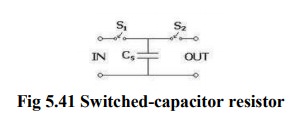Chapter: Linear Integrated Circuits : Waveform Generators and Special Function ICs
The Switched Capacitor Filter
The
Switched Capacitor Filter
Basic Representation:

The
simplest switched capacitor (SC) circuit is the switched capacitor resistor,
made of one capacitor C and two switches S1 and S2 which connect the capacitor
with a given frequency alternately to the input and output of the SC. Each
switching cycle transfers a charge q
from the input to the output at the switching frequency f. Recall that the charge q
on a capacitor C with a voltage V between the plates is given by:
q=CV
where
V is the voltage across the
capacitor. Therefore, when S1 is closed while S2 is open, the charge
transferred from the source to CS is:
qIN=CSVIN
And
when S2 is closed while S1 is open, the charge
transferred from CS to the load is:
qOUT
= CSVOUT
Thus,
the charge transferred in each cycle is:
Q=qOUT-qIN=Cs(VOUT-VIN)
Since
a charge q is transferred at a rate f, the rate of transfer of charge per
unit time is:
I=qf
Note
that we use I, the symbol for
electric current, for this quantity. This is to demonstrate that a continuous
transfer of charge from one node to another is equivalent to a current.
Substituting for q in the above, we
have:
I=Cs(VOUT-VIN)f
Let
us define V, the voltage across the SC from input to output, thus:
V=VOUT-VIN
We
now have a relationship between I and V, which we can rearrange to give an
equivalent resistance R:
R=V/I=1/Csf
Thus,
the SC behaves like a resistor whose value depends on CS and f.
The
SC resistor is used as a replacement for simple resistors in integrated
circuits because it is easier to fabricate reliably with a wide range of
values. It also has the benefit that its value can be adjusted by changing the
switching frequency. See also: operational amplifier applications.
This
same circuit can be used in discrete time systems (such as analog to digital
converters) as a track and hold circuit. During the appropriate clock phase,
the capacitor samples the analog voltage through switch one and in the second
phase presents this held sampled value to an electronic circuit for processing.
Switched Capacitor Circuits:
The
switched capacitor filter allows for very sophisticated, accurate, and tuneable
analog circuits to be manufactured without using resistors.
Advantages: resistors are hard to build on
integrated circuits (they take up a lot of
room), and the circuits can be made to depend on ratios of capacitor values
(which can be set accurately), and not absolute values (which vary between
manufacturing runs).
The Switched Capacitor Resistor:
Consider
the circuit shown with a capacitor connected to two switches and two different
voltages.

If
S2 closes with S1 open, then S1 closes with switch S2 open, a charge (q is
transferred from V2 to V1
with
Ōłåq=C1(v2-v1)
If
this switching process is repeated N times in a time (t, the amount of charge
transferred per unit time is given by
Ōłåq/Ōłåt=C1(v2-v1)
N/Ōłåt
the
number of cycles per unit time is the switching frequency (or clock frequency,
fCLK)
i=
C1(v2-v1) fCLK
Rearranging
we get
(v2-v1)
/ I = [ 1/ C1 fCLK ] -R
Which
states that the switched capacitor is equivalent to a resistor? The value of
this resistor decreases with increasing switching frequency or increasing
capacitance, as either will increase the amount of charge transferred from V2
to V1 in a given time.
The Switched Capacitor Integrator:
Now
consider the integrator circuit. You have shown (in a previous lab) that the
input-output relationship for this circuit is given by (neglecting initial conditions):

We
can also write this with the "s" notation (assuming a sinusoidal
input, Aest, s=jŽē)

If
you replaced the input resistor with a switched capacitor resistor, you would
get

Thus,
you can change the equivalent Žē' of the circuit by changing the clock
frequency. The value of Žē' can be set very precisely because it depends only on
the ratio of C1 and C2, and not their absolute value.
Switched Capacitor Filter ICs:
Some
of the Switched capacitor filter ICs is MF 5, MF10 and MF100
MF10:
The
MF10 contains two of the second-order universal filter sections found in the
MF5. Therefore with MF10, two second order filters or one fourth-order filter
can be built. As the MF5 and MF10 have similar filter sections, the design
procedure for them is same.

Related Topics